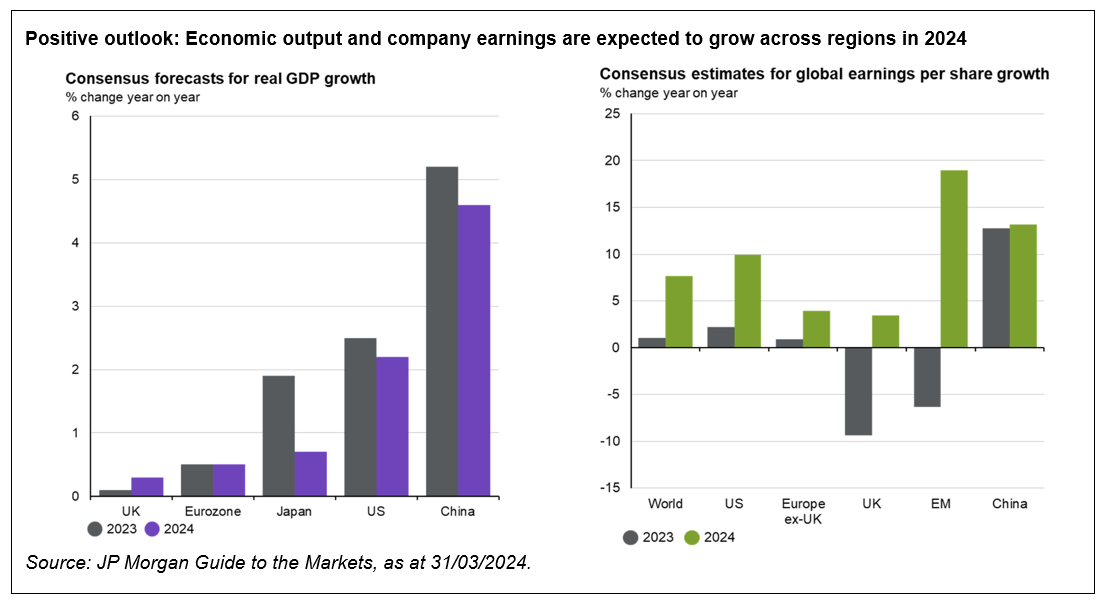Global equities entered the Easter weekend with their best first-quarter performance in five years, up 8% since the turn of the year and extending the rally that began at the end of October to gains of 24%. Momentum continued to be driven by US stocks which closed the quarter at record highs with the S&P 500 climbing 10% since the turn of the year and 25% since the start of November – to put this in perspective, the median annual gain for the index is 10%.
A feature of the market’s strong start to the year is that returns have roughly come in a straight line. Since selling-off last October, the S&P 500 hasn’t once fallen by as much as 2% – its longest such streak in six years – and the index posted 22 new all-time highs in the first three months of 2024. Another is that it has become increasingly broad. Around 70% of constituents traded above their 200-day moving average during the first quarter and the blue-chip index beat the tech-heavy Nasdaq 100 for the first time since Q4 2022.
This is welcome news for stock pickers like SKAGEN, particularly as the breadth has extended beyond the US. Many country indices hit all-time highs during the quarter, including Japan, Germany and France, while China has also rallied this year, gaining 3%, which is important for emerging markets. The picture is similarly positive on a sector basis with only real estate (-0.5%) failing to generate positive returns during the first quarter.
The rally also extended to other asset classes with gold – seen as a hedge against inflation uncertainty – and Bitcoin both reaching record highs in 2024. The cryptocurrency’s market size broke $1.4 trillion during the quarter, overtaking silver to become the world's eighth most valuable property.
Several themes we saw in 2023 carried into 2024 with big tech and AI-related stocks continuing to perform strongly, while renewable energy and regional banks struggled. These helped developed markets to outperform emerging ones by 7%, large caps to beat small caps by 5% and growth to exceed value by 3% during the first quarter.
Underpinning the rally has been an improving economic and earnings outlook. GDP is forecast to grow in most regions and labour markets around the world remain strong. Inflation generally continues to fall, albeit more slowly than expected in many countries, and interest rate cuts are within sight as a result. With investors increasingly convinced that we will achieve a soft economic landing and avoid recession, company earnings are expected to grow in all major markets.

Solid fund performance, positive outlook
Our funds have had a satisfactory start to the year with all except SKAGEN m2 generating positive absolute returns during the first quarter. You can read more about the drivers of performance and latest portfolio activity in the first quarter reports.
From a longer – and more important – perspective, our funds continue to deliver for clients. It is also pleasing that our long-term success has been recognised internationally with SKAGEN recently collecting a couple of awards. In Germany SKAGEN Global won the best fund in its category over 20 years and in the Netherlands SKAGEN was awarded the prestigious Golden Bull with the jury highlighting our contrarian approach, and consistency in the application of our investment philosophy.
Looking ahead, the market’s strong first quarter performance has pushed valuations above historic averages in general, although this is skewed by the US – now over 70% of the MSCI World Index – where stocks trade close to the top of their 30-year P/E range. Thankfully, we invest selectively rather than generally and there are areas where pricing remains attractive.
The valuation discount of small-caps to large-caps globally has continued to grow and reach previously unseen levels. These become particularly interesting when you consider that many smaller companies will likely be among the biggest winners from lower inflation, interest rate easing and a stronger economy.
Chinese equities can be picked-up at prices 60% cheaper than the US – another record discount – and 30% below their own 30-year P/E average. Again, this becomes even more exciting in the context of China’s improving economy and government initiatives to support the domestic stock market.
I recently returned from Korea where the authorities this year launched their ‘Value Up’ programme to address the longstanding weakness of corporate governance. The plans, which push company directors to address lacklustre valuations – commonly known as the ‘Korea Discount’ – follow similar initiatives in Japan which have yielded significant success for investors.
Risks hiding in plain sight
Another feature of rising markets is that risks tend to grow alongside investors’ exuberance. The latest sentiment surveys showed investors – professional and retail – to be more bullish than they have been for several years, while recent cryptocurrency highs and the reawakening of meme mania are also indicative of rising risk appetite.
While many dangers are hidden – Bloomberg recently reported how traders are buying protective options against a market correction – others are clearly visible. Markets globally have already pulled back in April – the MSCI ACWI is down around 4% in USD – as geopolitical tensions have risen in the Middle East and interest rate cuts appear further delayed by sticky inflation in the US and Europe.
The speed and strength of the market rally since October was clearly unsustainable and a correction looks likely at some stage, particularly as earnings expectations are heavily reliant on a handful of US technology companies and leave little room for disappointment.
These giants have continued to expand and now represent an oversized share of stock markets both domestically and internationally. It suffices to say that with Mag 7 insiders selling shares at the fastest rate since 2021, it is likely to be their minority shareholders – both active investors and those in passive funds – who feel a disproportionate amount of pain when the music inevitably stops.
History shows that stocks which have gained most have furthest to fall. If repeated, the issue for investors is likely to be how much of the market is brought down with US tech and AI-related names and how far it falls?
Experience also underlines the importance of diversification, stock selection and valuation to minimise downside risk. The potential cost of giving up some short-term gains if the current rally continues is a price worth paying long-term to be able to stay invested and sleep easy.
NB: All figures in USD as at 31/03/2024 unless stated otherwise. Fund performance net of fees. Market data based on MSCI indices unless stated otherwise.




